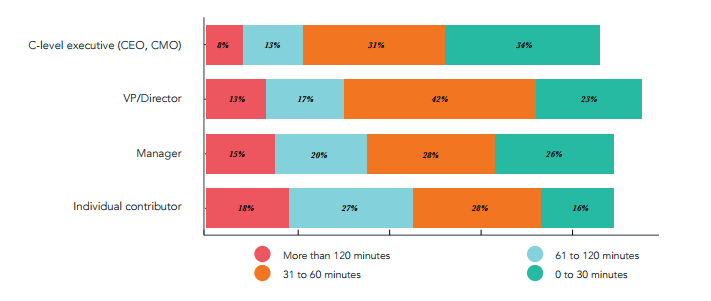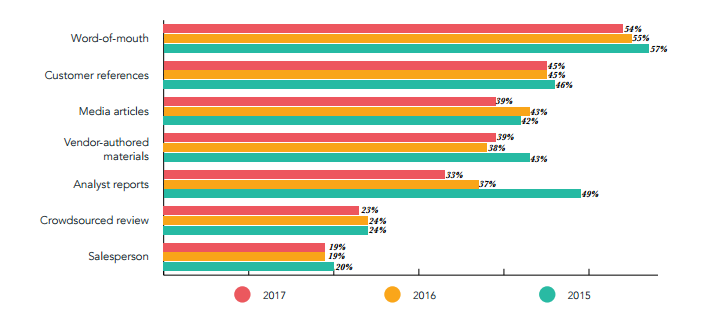HubSpot Revealed the State of Inbound for Marketing and Sales
By Venus Tamturk
May 24, 2017
content marketing, Content Strategy, CRM, Digital Marketing, Hubspot, inbound marketing, marketing, research, sales, sales cycle
Gone are the days of marketers throwing a bunch of content against a wall and waiting to see  what sticks, as they have made up so much ground through advanced technology tools in recent years. However, ever-increasing consumer expectations and the rapidly changing technology landscape still continue to raise a wide swath of issues for marketers, sales and the relationship between these two departments. To reveal those challenges and the top priorities, HubSpot surveyed 6,399 professionals in 141 countries and published the results in its annual report entitled State of Inbound 2017, covering the top challenges and priorities facing marketers and sales reps today. In this article, we will take a closer look at some prominent highlights from the survey.
what sticks, as they have made up so much ground through advanced technology tools in recent years. However, ever-increasing consumer expectations and the rapidly changing technology landscape still continue to raise a wide swath of issues for marketers, sales and the relationship between these two departments. To reveal those challenges and the top priorities, HubSpot surveyed 6,399 professionals in 141 countries and published the results in its annual report entitled State of Inbound 2017, covering the top challenges and priorities facing marketers and sales reps today. In this article, we will take a closer look at some prominent highlights from the survey.
Top Inbound Marketing Priorities
By now, as we all know content without access is worthless. Therefore, it is no wonder why 61 percent of marketers indicated in the survey that SEO and organic growth is their top priority. It is followed by creating more blog content that can be found via search with 53 percent and distributing and amplifying content with 47 percent. Besides these top three priorities, here is the breakdown for the rest of the top priorities with respect to inbound marketing projects:
Even though the order of these priorities may change depending on a region, overall, marketers are sharing the same inbound priorities on different levels. Latin American marketers, for instance, give more priority to interactive and visual content compared to others, whereas North American marketers focus more on their content distribution.
Another interesting finding under this category is that 32 percent of marketers surveyed find paid advertising (print, outdoor, broadcast) as the most overrated marketing tactic. Being a content creator and marketer, it is hard to disagree with this figure because through this tactic, understanding how well your marketing strategy is working is near impossible, where the ability to measure the performance of a marketing campaign is the whole point of executing marketing activities. Even though online paid advertising (social media ads, PPC) has been ranked third place in the category of overrated marketing tactics, in my opinion, in the near future we will see more marketers abandoning that tactic due to the ad-driven business model’s unfavorable impact on content, where the only thing that matters is if a web page stayed open long enough to make money.
Top Marketing Challenges
In the report, it is cited that marketers today find generating traffic and leads to be their biggest challenge, followed by proving ROI and securing budget for marketing programs.
As I said in my opening statement, throwing a bunch of content against a wall and waiting to see what sticks is not the way marketing works anymore, yet the majority of content created with that mindset never sees the light of day. In fact, the problem with content creation is that 65% of content is unused mostly because the content is not findable or relevant. Today, converting leads into customers is a continual focus for most marketers, thus marketers have become more data-driven and shifted from the traditional process of reaching out, creating awareness, and handing over sales, to the process of continuously nurturing them, teaming up with sales, and providing further content and campaigns for created leads throughout the whole customer journey.
As we will discuss more on the disconnect between sales and marketing in this article shortly, now let’s move on to the second most common marketing challenge: proving marketing ROI. In fact, mid-to-large B2B organizations lose an estimated $958 million each year because their content marketing has gone wrong. One of the reasons behind why proving marketing ROI is a challenge is the hardship of separating the cost of content creation from the overall marketing costs. According to SiriusDecisions, the total content creation investment for enterprise organizations, which generates over $1 billion in revenue, averages $17.5 million primarily spent on blog posts, emails, brochures, ads, Web pages and infographics. Moreover, the interesting fact is that enterprise organizations spend two times more than they think they do on content, and emerging growth organizations spend more than ten times.
Calculating the cost of content creation is relatively simple for those who outsource their content creation and management, as it is an explicit cost that shows up on vendor invoices, but internally created content, which represents the majority of content creation investment for organizations of all sizes, is harder to sort out as employees may wear multiple hats and get involved in the creation process.
The challenge of proving ROI for marketing activities leads marketers to face another challenge which is securing budget for marketing programs. In order to justify investments in marketing activities, marketers have to put a dollar figure on the creative process. Given $.25 of every dollar spent on content marketing in the average mid-to-large B2B firm is wasted on inefficient content operations, marketers need to make their case when they ask for internal and external resources for their marketing campaigns. More money can produce better results in content marketing, but not necessarily maximize ROI. If an organization allocates more budget for marketing activities but still they can’t receive the performance desired, then, marketers really need to look into ways of gaining leverage and maybe producing more valuable content with the same number of resources by optimizing operational tasks, taking advantage of collaboration, and rethinking overall content marketing production process.
Top CRM Challenges
Here at CMS-Connected, we often report on the huge enterprise software providers revamping their CRM capabilities by injecting machine learning and artificial intelligence technologies. Despite the continuous enhancements having been made to those platforms, according to the survey, data entry persists to be the top challenge to utilizing CRMs today, followed by a lack of integration. To investigate this point further, HubSpot inquired the amount of time salespeople are spending on data entry, and the result is that 57% of respondents are spending up to an hour per day on data entry. To me, this figure paints CRM productivity in a pretty negative light. However, I also believe that the underlying reason behind this situation might be the lack of knowledge on how to utilize the CRM platforms in place as well. To back up my point, the same survey disclosed that 18 percent of sales respondents didn’t even know how to answer our question on the biggest challenge in using a CRM.
Here’s a breakdown by seniority when it comes to how much time per day their sales team spends performing data entry or other manual tasks:

Marketing and Sales Alignment
There has been a distinctive disconnect between sales and marketing. The most common issue regarding the relationship between these two departments is that marketers’ contribution isn't valued by their counterparts in sales. As a matter of fact, some studies even claim that salespeople end up spending 30 percent of their time creating content themselves. There is a general perception that organizations simply should rest assured that the content creators are spending time and money on creating content being put to use and sales people's use of time isn't on searching and curating content when they’re supposed to be focused on closing the deals. I am not quite sure if I am sold on this perception as to me, this is exactly why organizations still have a major disconnect between sales and marketing.
To support my point, I would like to share a quote from one of our contributors, Janine Olariu’s  article: “The key realization is the following: sales and marketing alignment means that a linear success path becomes circular, and a campaign never truly ends, it just evolves.” If the sales team wants the marketing team to create a message or a story that would resonate with the target audience, in fact, salespeople have the most material to create effective marketing content. Of course, I do not mean that salespeople should spend less time with customers and more time with content curation. After all, salespeople have the most material because they are interacting the customers the most. What I mean is having the sales department share more specific and in-depth insight with their counterparts in marketing, whereas having the marketing department take more time to listen to those insights in an effort to mold them into a marketing message. In other words, marketing should be seen as a support department to sales, rather they both should be working as one inbound team.
article: “The key realization is the following: sales and marketing alignment means that a linear success path becomes circular, and a campaign never truly ends, it just evolves.” If the sales team wants the marketing team to create a message or a story that would resonate with the target audience, in fact, salespeople have the most material to create effective marketing content. Of course, I do not mean that salespeople should spend less time with customers and more time with content curation. After all, salespeople have the most material because they are interacting the customers the most. What I mean is having the sales department share more specific and in-depth insight with their counterparts in marketing, whereas having the marketing department take more time to listen to those insights in an effort to mold them into a marketing message. In other words, marketing should be seen as a support department to sales, rather they both should be working as one inbound team.
Paddling back to HubSpot’s survey, the findings back me up and indicate that organizations which are inbound are more likely to state that their marketing strategy is effective. On the other hand, the majority of respondents who are part of outbound organizations do not think their marketing strategy is effective.
Another interesting finding in this regard is that 44 percent of respondents say Marketing and Sales are generally aligned, while 22 percent indicate there’s a formal service level agreement (SLA) in place between teams. Given that HubSpot has done this annual market research for eight consecutive years, this year, they concluded that marketing respondents whose organizations have an SLA in place are 3x more likely to say their strategy is effective compared to those in misaligned organizations.
Lastly, it also shouldn’t be forgotten that many buyers are already making their decisions long before they create contact with sales or a support department. A study by Forrester discovered that as many as 72% of customers prefer to use a self-help option rather than reach out to a company as modern customers tend to be self-researchers. Therefore, the point of content marketing efforts shouldn’t only be supporting salespeople but also serving strategically to influence their potential buyers. During the survey, the respondents were asked what sources of information they rely on when making a purchase decision for business software, and here’s the rundown of the answers given in the recent three years:

If you would like to hear more on how to best bridge the gap between the sales and marketing teams tune into the CMS-Connected Show recorded with a LIVE audience at 404 Conference as we welcomed a panel of well-known expert guests to the show including Bruce Williams, Keith Durrant, Michael Kinkaid, and Vince Mayfield:
You can also watch the full show divided into bite-sized segments here.
My POV
Based on challenges and priorities cited in the report discussed in this article, organizations should make content easier to find and use by increasing its quality and relevance to target audiences. To accomplish this proper course of action, they need to adopt the sales and marketing alignment concept as well as a documented content strategy. From there, to understand if that strategy is working or not, they need to find out their content and marketing ROI. Based on the findings, the strategy should be continuously updated to keep up with ever-changing ways of interacting with customers and the technology landscape.

Venus Tamturk
Venus is the Media Reporter for CMS-Connected, with one of her tasks to write thorough articles by creating the most up-to-date and engaging content using B2B digital marketing. She enjoys increasing brand equity and conversion through the strategic use of social media channels and integrated media marketing plans.